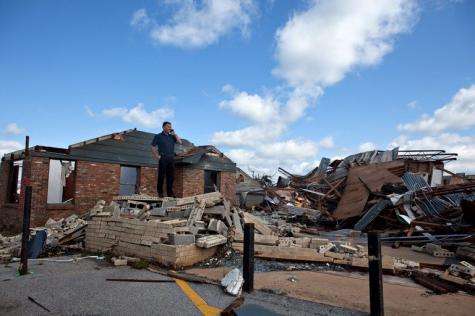Tornadoes whipped up by wind, not climate: officials

US meteorologists warned Thursday it would be a mistake to blame climate change for a seeming increase in tornadoes in the wake of deadly storms that have ripped through the US south.
"If you look at the past 60 years of data, the number of tornadoes is increasing significantly, but it's agreed upon by the tornado community that it's not a real increase," said Grady Dixon, assistant professor of meteorology and climatology at Mississippi State University.
"It's having to do with better (weather tracking) technology, more population, the fact that the population is better educated and more aware. So we're seeing them more often," Dixon said.
But he said it would be "a terrible mistake" to relate the up-tick to climate change.
The tornadoes that ripped through the US south this week killed over 250 people, in the worst US weather disaster in years, with residents and emergency workers sifting through the rubble on Thursday.
Violent twisters that famously rip through the US south's "Tornado Alley" are formed when strong jet winds bringing upper-level storms from the north interact with very warm, humid air mass from the Gulf of Mexico, said David Imy from the NOAA Storm Prediction Center in Norma, Oklahoma.
On Wednesday, a particularly potent storm was whipping up around the heart of that tornado-prone corridor where the states of Arkansas, Oklahoma, eastern Texas and northwest Louisiana meet, noted Kristina Pydynowski, a senior meteorologist at the AccuWeather.com website.
Sparking the severe thunderstorms from that point was the much warmer air arriving from the south, over the tropical Gulf. The combining winds at differing altitudes, said Pydynowski, created "significant twisting motion in the atmosphere, allowing the strongest thunderstorms to spawn tornadoes."
Such a mixture would not be prevalent along the US eastern seaboard, so rough weather in that region Thursday would not also spawn tornadoes, at least on the same scale, she said.
Craig Fugate, administrator of the Federal Emergency Management Agency (FEMA), also dismissed Thursday climate change as a factor in the deadly tornadoes: "Actually what we're seeing is springtime," he said.
"Many people think of Oklahoma as 'Tornado Alley' and forget that the southeast United States actually has a history of longer and more powerful tornadoes that stay on the ground longer."
Wednesday's deadly tornadoes, according to Imy of the National Oceanic and Atmospheric Administration, were unusual for being "long track," meaning they were on the ground for a longer period of time than usual -- in this case, roiling across the land for 30 miles (48 kilometers) or more.
An average track would be less than five miles, said Imy.
However, the stronger-than-usual tornadoes affecting the southern states were actually predicted from examining the planet's climatological patterns, specifically those related to the La Nina phenomenon.
"We knew it was going to be a big tornado year," he said. But the key to that tip-off was unrelated to climate change: "It is related to the natural fluctuations of the planet."
(c) 2011 AFP

















